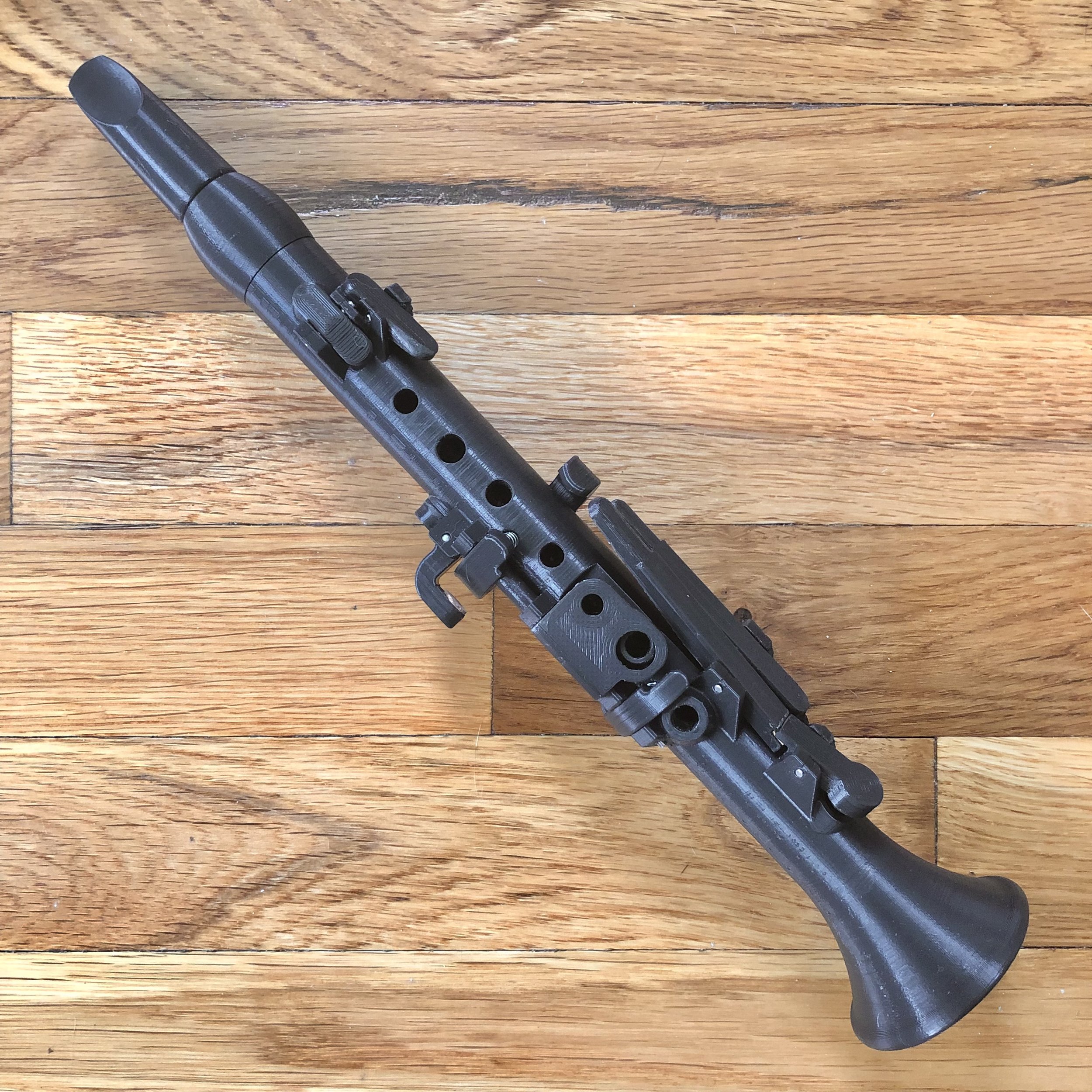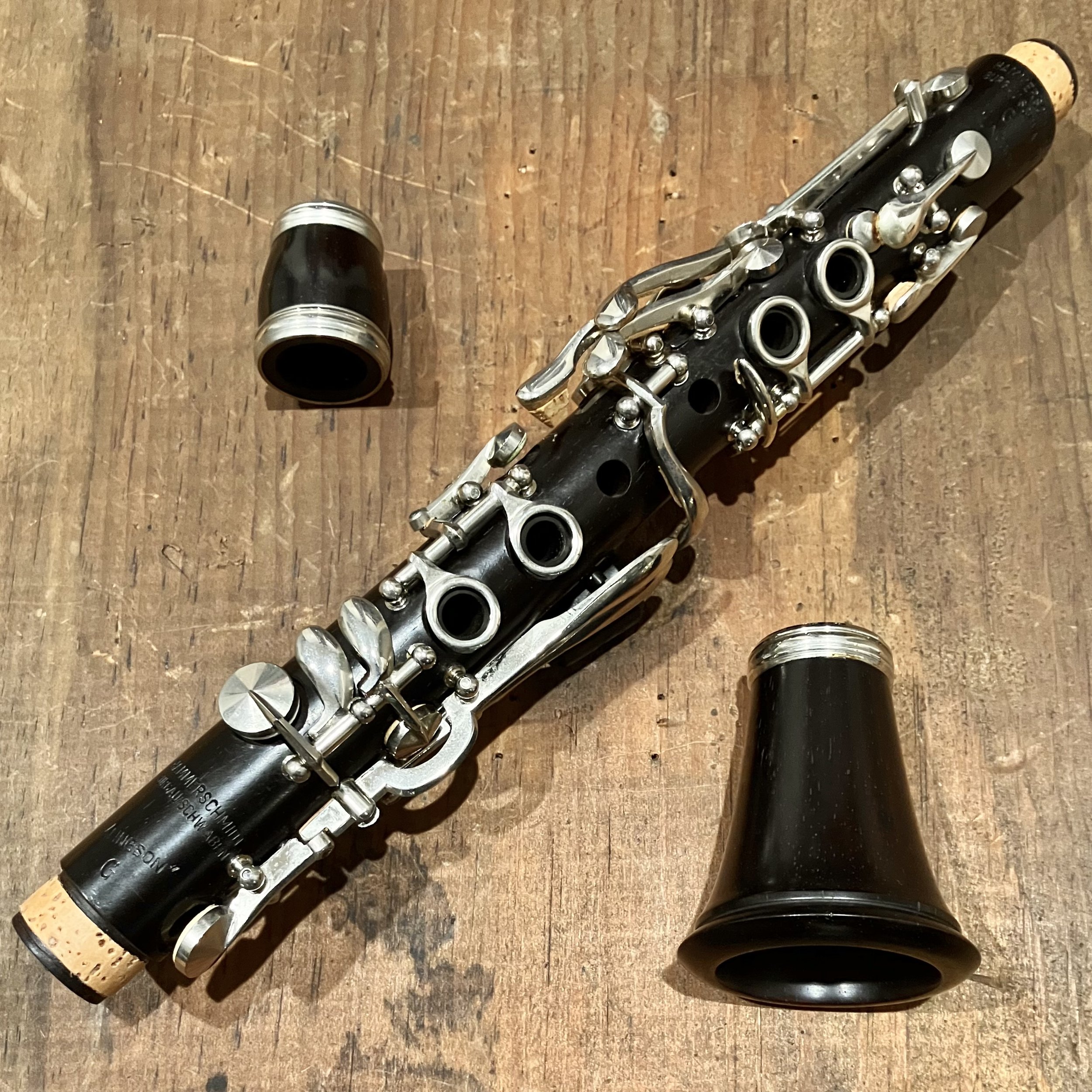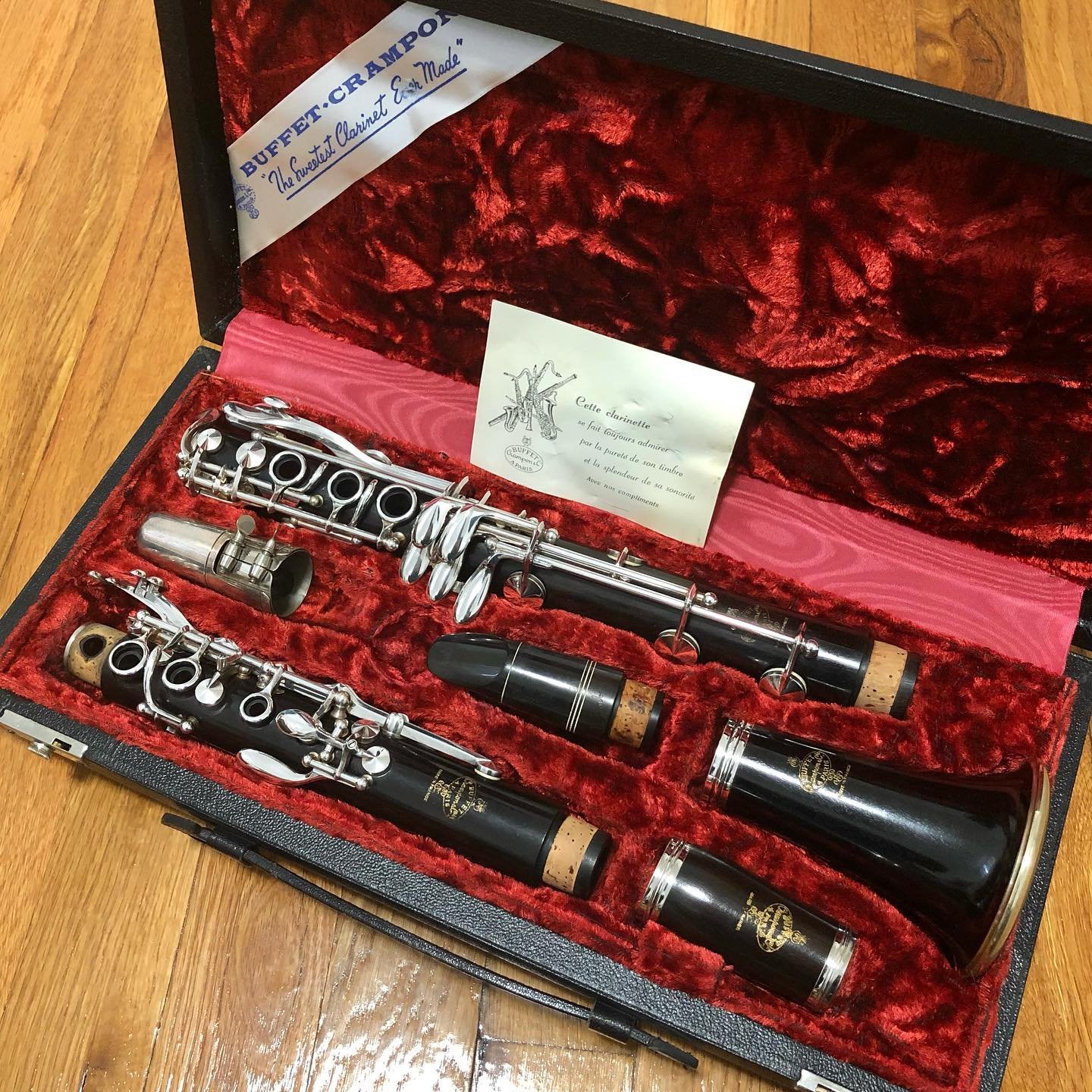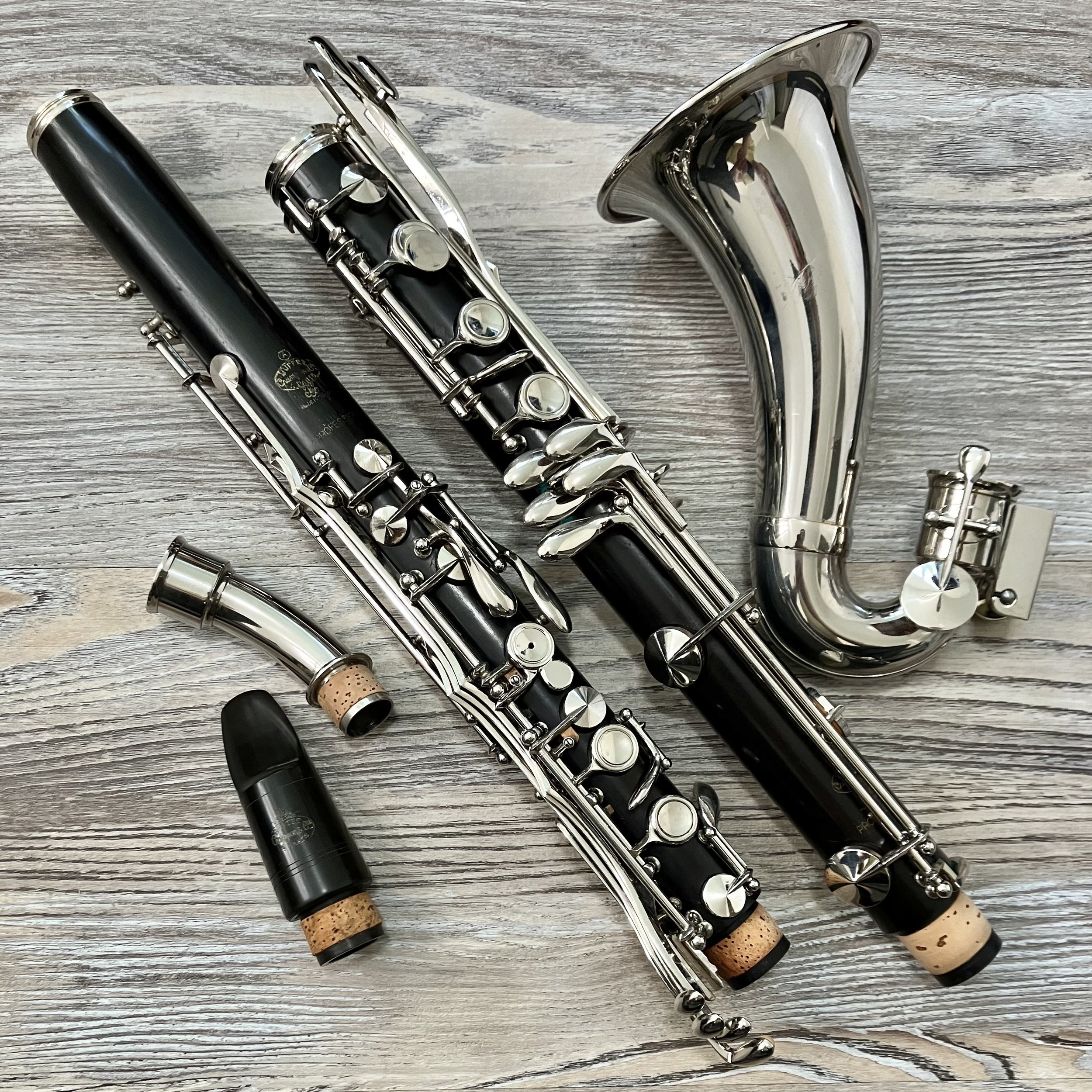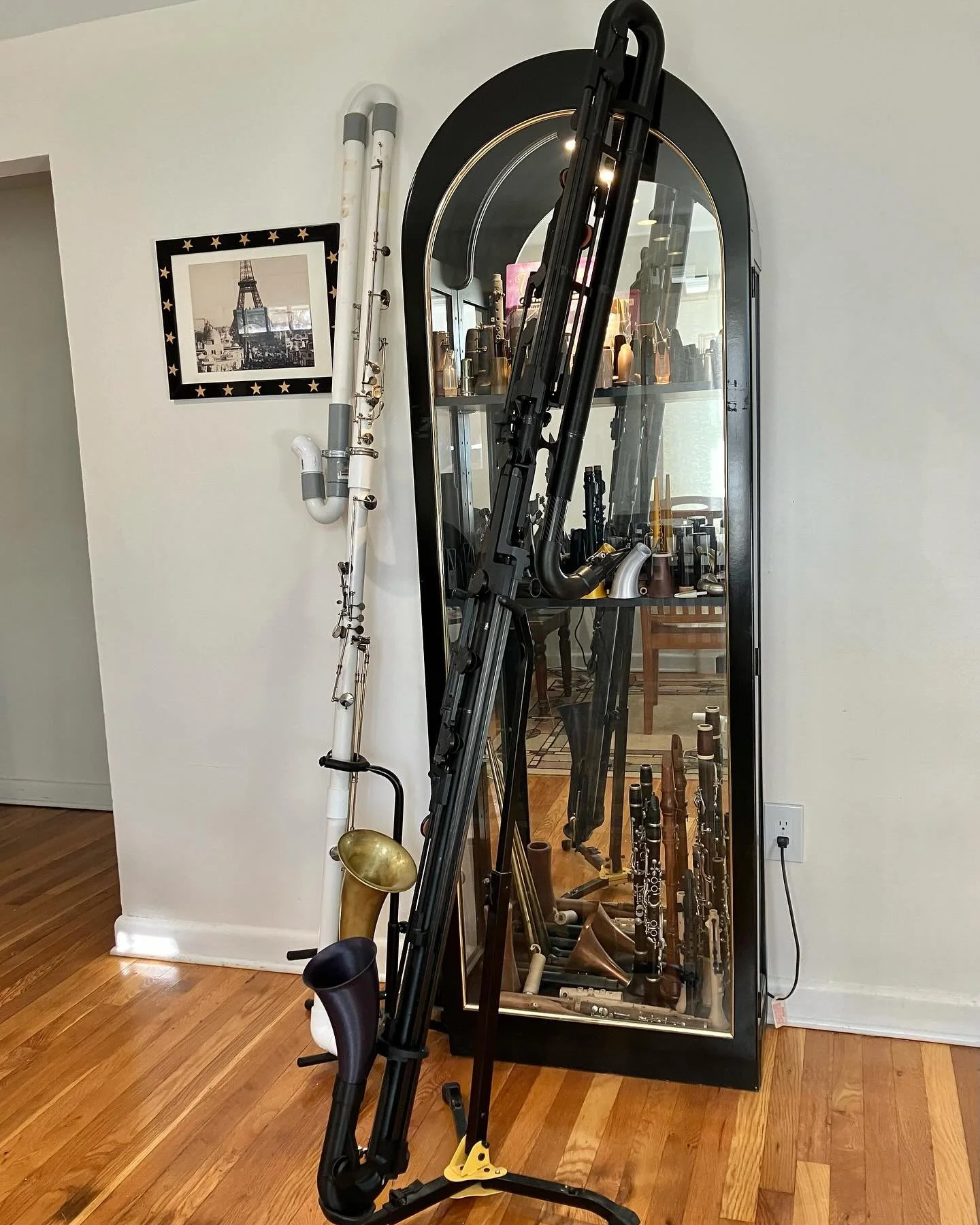The Complete Clarinet Family
One of my more lofty goals is to complete a collection of all known members of the clarinet family. With at least 27 members this is certainly a daunting challenge, especially considering that I am neither a museum director nor a millionaire. To my knowledge none have done this, some have gotten close but there are always a few oddball instruments out there that are nearly impossible to acquire. Why go through with such an ambitious plan? Well in addition to the “cool factor”, I feel that there is a lot that can be learned from studying the design of different members of the clarinet family. For example, the design of my contrabass clarinet mouthpiece was a direct result of my experiments with octocontrabass clarinet mouthpieces. Thanks to a bit of luck with online auction sites and some stubbornness when it comes to fixing up instruments that should otherwise have been wall hangers, I’ve managed to complete a good chunk of the collection. What I can’t find I will attempt to build. Here are my “rules” for the collection:
A clarinet is a single reed instrument with a mostly cylindrical bore overblowing at a 12th. It must have a flared bell, a register vent and have a fully chromatic range from at least written E3 to C6+.
Boehm system is preferred, otherwise it must have at least 5 keys (chalumeaux and 3 key student clarinets do not count).
It must be made of stable materials and be designed to last (so for example a papier-mâché clarinet would not count no matter how well it played!)
It must be part of the collection (Renting an octocontrabass clarinet would be cool, but it’s hard to learn a lot from an instrument you only have access to for a short time)
Key is the deciding factor between different members of the clarinet family, not range or bore size (so for example there is no need to acquire both an alto clarinet in F and a basset horn.)
The instrument must be tuned to low pitch and be able to play with modern instruments with acceptable intonation.
The key must be the one the original maker intended (A high pitch A clarinet that plays as a Bb does not count.)
Here is my progress so far:
X C Piccolo (octave) clarinet
The smallest known clarinet. In my year’s of searching I’ve only seen one, an unusual instrument that sold on an internet auction years ago. Its whereabouts today are unknown, presumably it is sitting in some collection somewhere.
✓ Bb Piccolo (octave) clarinet
My most ambitious project to date. This clarinet was the result of me attempting to make my first full clarinet with metal key work. It features 10 solid brass keys and uses simple system fingerings with Boehm fingerings for the right hand.
✓ A Piccolo (octave) clarinet
This instrument was an experiment to see if it was possible to 3D print an entire clarinet, keys and all, on a standard FDM printer. Originally it was supposed to be in Bb, but because I neglected to account for certain acoustic phenomena the first keyless prototype ended up in A. Rather than scrap many hours of work I decided to finish the instrument in A. The end result was surprisingly good, I would even say the finger spacing is better than my Ab clarinet, mostly thanks to the simplified key work. Best of all you can make one yourself!
✓ Ab Piccolo clarinet
The smallest “common” size of clarinet. Quite hard to find in most parts of the world but interestingly enough at one point these were somewhat common in Italy. That’s where this Orsi is from. This instrument was overhauled by me with ‘roo leather pads. Intonation is surprisingly good for a piccolo clarinet, with many having 12ths that do not line up properly.
✓ G Piccolo clarinet
Up until recently, only German system G piccolo clarinets were available. My personal example is a Hammerschmidt.
X F clarinet
Back in the early days of the clarinet this was actually one of the more commonly seen sizes, used to replace the trumpet in F. You do occasionally see simple system F clarinets on online auction sites. In fact at one point I owned an O’Brien “Primer” clarinet with pseudo-Boehm key work that I foolishly sold for a very low price. I’ve also talked to composer Bret Newton quite a bit regarding the possibility of building a modern version with Boehm system key work. Our ideal vision for the instrument would be one that uses a German Eb mouthpiece and has a bore slightly smaller than the standard Eb clarinet. This instrument would be a great way to achieve the bright piercing tone of the piccolo clarinets without the intonation and embouchure difficulties.
? E natural clarinet (Honorable mention)
I’ve seen several references to an E natural clarinet, yet no credible evidence that such an instrument existed. I can only assume that any instrument claimed as such is actually a high pitch Eb clarinet. In fact I actually own such an instrument, however I do not consider it to be an E natural clarinet despite the fact that it functionally plays as one.
✓ Eb clarinet
One of the more common sizes of clarinet. My personal example is a 1980s R13.
✓ D clarinet
Once one of the more common sizes of clarinet, now very rarely seen, especially outside of Germany. My personal example is a German system instrument made by A. Seeholzer in Affoltern Switzerland.
✓ C clarinet
Another instrument that was more common in the past, though there has been a bit of a resurgence of interest in this instrument. This is the only non-transposing member of the clarinet family (by modern playing standards at least). My current instrument is a 1920 Buffet that I overhauled leather pads.
X B natural clarinet
This one is a bit controversial, in that many claim to own a B natural clarinet yet there are no conformed examples save for a few reproductions of classical instruments. Most “B natural clarinets” are almost certainly high pitch B flat clarinets that happen to play sharp enough to be mistaken for being in the key of B natural. This is especially evident given the fact that many alleged examples are seen without their original barrel. This brings up an interesting question, for the sake of completeness would it be fair to turn a high pitch Bb clarinet into a low pitch B natural clarinet? In my opinion no since the original maker did not intend for the instrument to be in the key of B natural , which means at some point I may consider the possibility of building my own B natural clarinet. My idea is to steal the key work from a high pitch clarinet and construct my own body, bell and barrel. To me that would be the equivalent of building an instrument in B, but I digress...
In response to the many claims of people who believe that they have a B natural clarinet, I have put out a $50 bounty for the first person that can provide me with an original piece of documentation that proves that modern B natural clarinets we made in the late Romantic/early Modern era (~1875 to about 1950). This can be in the form of a catalog, invoice or a piece of sheet music from the era. It must be direct evidence, not circumstantial evidence or a non-primary source. If you have evidence that fits these requirements, please reach out to me here.
✓ Bb clarinet
This member needs no introduction. At any given time I have anywhere from 3 to 10 Bb clarinets in my shop. Pictured here is my 1967 full Boehm R13 in near factory original condition. Got very luck on this one.
✓ A clarinet (and basset clarinet)
Another standard member of the clarinet family, most often used in orchestras. My personal example is another R13, this time from the 1980s. I restored it myself with leather and cork pads (yes I cleaned up the logos after taking this picture, it bothered me too…). I also have a Ridenour basset lower joint that converts this into a basset clarinet.
X Ab clarinet
These mostly existed in the past as clarinet d’amour. I have toyed with the idea of building a modern version, but admittedly it would be a fairly useless instrument Interestingly enough Heckel offered these in one of their older catalogs, so there is a possibility of some 19th century instruments being out there.
✓ G clarinet/clarinet d’amour
One of my favorite members of the clarinet family. For the longest time I was searching for a Boehm system version, even going as far as converting an Albert system G clarinet into a sort of half-Boehm instrument. Eventually manufacturers in China started offering them and for awhile I was content. I experimented with bulbous bells and curved necks and made what I consider to be the first Boehm system clarinet d’amour in G. Eventually however I learned of one musician’s project where they commissioned a clarinet d’amour in G with a range to low C. I was intrigued by the possibility of this instrument and built my own version with my own key work system for the basset notes. This instrument was converted from a standard Chinese Boehm system G clarinet that I overhauled and tuned before adding the extension. The neck and bell are 3D printed like my other accessories.
✓ F basset horn/F alto clarinet
Another one of my favorite members of the clarinet family. The basset horn has been used on and off since the classical era. Recently it has seen some resurgence in popularity, though the lack of affordable instruments has prevented this member of the clarinet family from experiencing widespread use in modern times. I got very lucky with my personal instrument, a 1967 Buffet “Professional”. It was being sold as an alto clarinet and I managed to snag it up for a great price. Eventually I gave it an overhaul with Italian leather and cork pads. This particular instrument is a small bore (15.65mm) and uses a slightly modified Bb clarinet mouthpiece. I’ve also made a matching rosewood composite neck and straight bell set for it.
? E natural basset horn/alto clarinet (Honorable mention)
I’ve seen several references to a low clarinet in E natural, yet there is no credible evidence that such an instrument existed. I can only assume that any alleged examples are actually high pitch alto clarinets. I have no plans to make such an instrument.
✓ Eb alto clarinet
The black sheep of the clarinet family. I have a special place in my heart for the alto clarinet. In fact it was the first member of the clarinet family I ever played. The thing with alto clarinet is that while there are some really good examples out there, there are also a large number of terrible instruments… Fortunately I was able to find a very nice 1972 Buffet “Professional” alto clarinet to match my basset horn for a very good price. Better yet the instrument already had a recent overhaul when I got it.
X D basset horn/alto clarinet
Surprisingly there is a known example of an unusual square shaped basset horn in D dating from the 18th century. Certainly the only hope of acquiring a modern version would be to build one. I imagine the easiest option would be to reuse some key work from an alto clarinet. I’m imagining an instrument very similar to the alto clarinet that uses the same mouthpiece. A range to low C would also have historical precedence.
✓ C bass clarinet
This is my favorite instrument in my collection, just for how rare and unusual it is. Until a few years ago I assumed there were no modern C bass clarinets. I saw this instrument on a French auction site and immediately noticed how tight the spacing on the right stack was. On a whim I placed a bid and won this bass clarinet for a very good price. I lucked out as not only was it in C but it also tuned perfectly to 440Hz - 442Hz depending on how much I pulled out the neck/middle joint. It also showed almost no signs of wear, understandable for an instrument with almost no literature. It uses a standard bass clarinet mouthpiece and has a fairly typical bore of 23.5mm at the body joints and 24mm at the neck, which is roughly the same as the new Buffet Prestige model. The most surprising thing about this instrument is that it was made around 1948 according to the serial number, making it the most recent known example of a Boehm system bass clarinet in C, at least until someone makes another. I gave it a full overhaul (though I did elect to leave the patina on the key work) with Italian leather pads that closely matched the original pads (I try to do this on any instrument of historical importance). At the time of writing there are only 8 known bass clarinets in C with Boehm system key work (3 Selmers, 4 Buffets and one Adler) making it one of the rarest modern members of the clarinet family. At least one manufacturer has advertised that they will make one on custom order.
✓ Bb bass clarinet
By far the most popular harmony clarinet. I consider bass clarinet to be my main instrument (as in that’s what I play most often). At the moment I have both a Royal Max and a 1947 Buffet bass clarinet (shown).
✓ A bass clarinet
Certainly one of the more perplexing members of the clarinet family. It’s existence is entirely the result of an incorrect assumption by Richard Wagner. Scraping enough money together for one bass clarinet is hard enough, so it’s easy to see why this instrument died out. How I got my hands on this instrument is an incredible story. Like many of my other lucky finds it was mislabeled as a Bb bass clarinet. Unfortunately my luck ran out as this instrument was hiding some secrets. At some point in the past someone had attempted to convert this instrument into a Bb bass clarinet. In fact when I received it I assumed it was in Bb, that is until I noticed the terrible intonation and the signs of modifications on the tone holes and neck. Someone had cut down the neck and middle joint and enlarged the tone holes (with what appeared to be a chainsaw…) in order to make it play close to a Bb bass clarinet. Of course anyone who knows the first about acoustics will tell you that it is impossible to retune a clarinet to another key so this essentially ruined the instrument. Stubborn as I am I decided to take on the 1/2 year long challenge of restoring this instrument back to an A bass clarinet. This involved making custom tone hole inserts to bring the tone holes back to their original size and adding a tuning slide to the neck to bring it back to it’s original length. At some point in history a low Eb extension was also added, though being designed for a Bb bass clarinet it was of course not long enough so a small extension was turned and fit to the end of the lower joint. The end result was… actually quite good. Great even, with the mouthpiece that originally came with the instrument it plays a very even scale across the entire range. To date there are around a dozen known surviving bass clarinets in A with Boehm system key work (by my count 6 Selmers, 3 Buffets, 2 Foxes and 1 Orsi. There are also as many as 23 additional Selmers that have unknown whereabouts according to serial number records.) so I certainly lucked out finding this instrument. At least 2 manufacturers advertise that they will produce an A bass clarinet on custom order, however one has stated that they will likely not make any more due to the significant labor involved.
✓ G bass clarinet
Another member of the clarinet family where it is not clear whether they actually existed historically. Only one second or possibly third hand source makes mention to one. In “The Clarinet” Rendall writes:
“[A contrabasset horn] was announced by Ernst Schmidt, the well-known maker of Mannheim, in the 1930s. It was stated to be pitched in G and to descend to written D.”
This single sentence and a list of clarinet pitches in the beginning of the book is all we have to go on. In any case let’s try to dissect it. “Announced” is a very vague term. Could this mean that the instrument was planned but never finished? This is a strong possibility as 1930s Germany was a dangerous place to be. With the effects of the great depression being felt worldwide and and the rise of Nazism it was not a favorable environment for the creation of a new unique instrument. The use of “stated” also suggests that this is at the very least a second hand source. The book was also published in 1954 so there is some time between the creation of this supposed instrument and the earliest documentation we have of it’s existence. In any case Mannheim was very heavily damaged during WWII so it is entirely possible that an instrument was made and was destroyed during the war leaving nothing but second hand accounts. Given this it could be concluded that there is not enough evidence to say a G bass clarinet/contra alto clarinet ever existed and there would be no need to include one in the collection.
But…
Why not acquire one anyway? Yes it would not be prudent to make my job harder by creating an entirely new member of the clarinet family, but I think the idea of a bass clarinet in G may have some potential. If composers utilized the bass clarinet in A for it’s darker tone in the past then there may be room for an even darker sounding instrument that can still comfortably play in keys with many sharps. With that I set out doing something never attempted before, making a low clarinet utilizing mostly 3D printed parts. This method greatly reduced development time, taking only a matter of months instead of years. The end result is quite promising. The instrument I designed utilizes simplified Boehm system key work with manual register vents. There is still a long way to go, but I believe the concept definitely has potential.
X F bass clarinet/contra alto clarinet
Sometimes called a “contrabasset horn” these instruments briefly existed in the 19th century only to be replaced by the Eb contra alto clarinet. If I were to build one I would build it in the style of a bass clarinet with a bass clarinet mouthpiece much like my G bass, though I have no plans to at the moment.
✓ Eb contra alto clarinet (contralto clarinet)/great bass clarinet
One of the most useful yet most neglected members of the clarinet family. These saw the most widespread use in the mid 20th century, though they were gradually upstaged by the Bb contrabass clarinet. They are also the least standardized member of the clarinet family with almost every manufacturer using their own bore size and mouthpiece type. I personally own a Bundy.
X C contrabass clarinet
Another relic of the 19th century. Once again this contra clarinet was replaced by its larger sibling. It’s hard to imagine what a modern version would look like. Some might advocate for it to use a smaller mouthpiece than the Bb contrabass clarinet and be built more like a large contra alto clarinet. I would personally advocate for it to use the same bore and mouthpiece as the modern Bb contrabass clarinet and be built in a similar shape to the “Paperclip” instruments. I have no plans to build one at the moment however.
✓ Bb contrabass clarinet
This is the lowest common clarinet you are ever likely to see outside of a museum. They have become more common in recent years to the point where even many high schools will have one. I personally have the very popular Leblanc 340 “Paperclip”. Originally it only hand a range to low D, however I built my own low C extension for it.
✓ Octocontra-alto clarinet (Octocontralto clarinet)
Currently the largest playable size of clarinet. In January of 2025 I completed my first working prototype! At the moment the only other octocontra-alto in the world is the one instrument made by Leblanc in the 1970s.
X Octocontrabass clarinet
Only two playable instruments have been built so far, the original by Leblanc and a prototype by Martin Foag. Constructing one is another one of my projects. My first prototype utilized salvaged bass clarinet keys and ABS tube but had poor acoustics. My current prototype uses solenoids to control the keys. I am not sure when I will have a playable prototype, hopefully soon.


